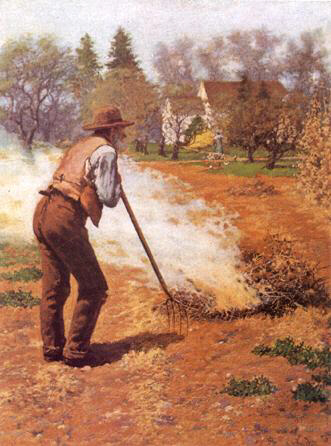
Corn: Builder of Cities
 |
Corn: Builder of Cities |
Were it not for corn, acheologists say, the Spaniards would have been mightily disappointed when they arrived in the Americas. There would have been no Aztecs with floating cities and carved pyramids to conquer, no vast Indian armies with whom to do battle. The conquistadors likely would have left Peru empty-handed, for there would have been no Incan empire offering temples paneled in gold and stocked with jeweled icons. Corn was what made the great civilzations of Central and South America possible: it supplied the calories that nourished the thriving populations required to build complex societies.
Christopher Columbus first sampled corn in Cuba. he was impressed, declaring it "most tasty boiled, roasted, or ground into flour." When he returned to spain, he took along a few specimen Indians, some handfuls of gold dust and a packet of corn kernels. Those first seeds may not have made a big impression on Ferdinand and Isabella, but they quickly proved their value. Within a few years the Saniards had introduced maize around the Mediterranean. by the mid-16th century corn was so familiar in the Southern European diet that it formed the basis of such national dishes as Italian polenta and Romanian stable mamaliga (a sort of cornmeal mush). corn also traveled to the Philippines and the rest of Asia; by 1560 it was fixture in Chinese cooking, in everything from porridge to stir-fry.
Portuguese traders, who used corn as slave-ship stores, carried the grain to Africa. It was an instant success there: corn grew more rapidly than other grains, and it needed very little cultivation. you could plant it and then pretty much ignore it until harvest time. corn weathered drought and the harsh African sun better than other staple foods. But its advent in Africa was not an unmixed blessing. It produced something of a population boom, which may in turn have fed the slave trade. In addition, says Robert Hall, "Europeans used slave labor in Africa for cultivating New World crops like corn, yams and cassava to provision the slave ships." And it led to a serious imbalance in the African diet. But by the late 18th century, many Africans ate almost nothing but corn. and suffered from vitamin deficiency as a result. Africans today are still afflicted by pellagra or "mealie disease," a sicness related to malnutrition from overreliance on corn.
In the Americas, Indians who depended on maize combined it with tomatoes, capsicum peppers and sometimes fish -- all of which contain the necessary vitamins to make up for the deficit in corn. In fact, corn on its own provided only about a third the calories of Old World staples like sorghum and millet. In Europe, humans never really took to corn, but it became a mjor source of fodder for animals and helped improve mutrition by making meat cheaper.
Today, corn continues to relieve the planet's hunger -- and slake its thirst. any portrayal of the Pilgrims' first Thanksgiving would be incomplete without the requisite display of Indian maize, but what probably made the meal so festive was a native brew of fermented corn. Later, less puritan immigrants took the process a few steps further to make that most American of liquors, bourban whiskey. Corn is the staple food of 200 million people in Africa and Latin America, and Americans consume an average of three pounds of corn a day in the form of meat, poultry and dairy products. And it's not just food: corn is used in products from baby powder to embalming fluid -- the cradle to the grave.
(information supplied by Alfred Crosby's book The Columbian Exchange)
Have Questions Or Comments? Email Jay Edwards
Back to Class Page